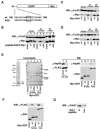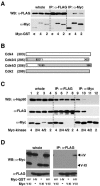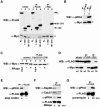Cdc37 interacts with the glycine-rich loop of Hsp90 client kinases
- PMID: 16611982
- PMCID: PMC1447410
- DOI: 10.1128/MCB.26.9.3378-3389.2006
Cdc37 interacts with the glycine-rich loop of Hsp90 client kinases
Abstract
Recently, we identified a client-binding site of Cdc37 that is required for its association with protein kinases. Phage display technology and liquid chromatography-tandem mass spectrometry (which identifies a total of 33 proteins) consistently identify a unique sequence, GXFG, as a Cdc37-interacting motif that occurs in the canonical glycine-rich loop (GXGXXG) of protein kinases, regardless of their dependence on Hsp90 or Cdc37. The glycine-rich motif of Raf-1 (GSGSFG) is necessary for its association with Cdc37; nevertheless, the N lobe of Raf-1 (which includes the GSGSFG motif) on its own cannot interact with Cdc37. Chimeric mutants of Cdk2 and Cdk4, which differ sharply in their affinities toward Cdc37, show that their C-terminal portions may determine this difference. In addition, a nonclient kinase, the catalytic subunit of cyclic AMP-dependent protein kinase, interacts with Cdc37 but only when a threonine residue in the activation segment of its C lobe is unphosphorylated. Thus, although a region in the C termini of protein kinases may be crucial for accomplishing and maintaining their interaction with Cdc37, we conclude that the N-terminal glycine-rich loop of protein kinases is essential for physically associating with Cdc37.
Figures





Similar articles
-
Restricting direct interaction of CDC37 with HSP90 does not compromise chaperoning of client proteins.Oncogene. 2015 Jan 2;34(1):15-26. doi: 10.1038/onc.2013.519. Epub 2013 Dec 2. Oncogene. 2015. PMID: 24292678 Free PMC article.
-
A client-binding site of Cdc37.FEBS J. 2005 Sep;272(18):4684-90. doi: 10.1111/j.1742-4658.2005.04884.x. FEBS J. 2005. PMID: 16156789
-
Identification of a conserved sequence motif that promotes Cdc37 and cyclin D1 binding to Cdk4.J Biol Chem. 2004 Mar 26;279(13):12560-4. doi: 10.1074/jbc.M308242200. Epub 2003 Dec 30. J Biol Chem. 2004. PMID: 14701845
-
How Hsp90 and Cdc37 Lubricate Kinase Molecular Switches.Trends Biochem Sci. 2017 Oct;42(10):799-811. doi: 10.1016/j.tibs.2017.07.002. Epub 2017 Aug 4. Trends Biochem Sci. 2017. PMID: 28784328 Free PMC article. Review.
-
Supervision of multiple signaling protein kinases by the CK2-Cdc37 couple, a possible novel cancer therapeutic target.Ann N Y Acad Sci. 2004 Dec;1030:150-7. doi: 10.1196/annals.1329.019. Ann N Y Acad Sci. 2004. PMID: 15659792 Review.
Cited by
-
Phospho-proteomic analyses of B-Raf protein complexes reveal new regulatory principles.Oncotarget. 2016 May 3;7(18):26628-52. doi: 10.18632/oncotarget.8427. Oncotarget. 2016. PMID: 27034005 Free PMC article.
-
Oral administration of an HSP90 inhibitor, 17-DMAG, intervenes tumor-cell infiltration into multiple organs and improves survival period for ATL model mice.Blood Cancer J. 2013 Aug 16;3(8):e132. doi: 10.1038/bcj.2013.30. Blood Cancer J. 2013. PMID: 23955587 Free PMC article.
-
Regulation of Greatwall kinase by protein stabilization and nuclear localization.Cell Cycle. 2014;13(22):3565-75. doi: 10.4161/15384101.2014.962942. Cell Cycle. 2014. PMID: 25483093 Free PMC article.
-
Arabidopsis TRIGALACTOSYLDIACYLGLYCEROL5 Interacts with TGD1, TGD2, and TGD4 to Facilitate Lipid Transfer from the Endoplasmic Reticulum to Plastids.Plant Cell. 2015 Oct;27(10):2941-55. doi: 10.1105/tpc.15.00394. Epub 2015 Sep 26. Plant Cell. 2015. PMID: 26410300 Free PMC article.
-
ATP-competitive inhibitors block protein kinase recruitment to the Hsp90-Cdc37 system.Nat Chem Biol. 2013 May;9(5):307-12. doi: 10.1038/nchembio.1212. Epub 2013 Mar 17. Nat Chem Biol. 2013. PMID: 23502424 Free PMC article.
References
-
- Basso, A. D., D. B. Solit, G. Chiosis, B. Giri, P. Tsichlis, and N. Rosen. 2002. Akt forms an intracellular complex with heat shock protein 90 (Hsp90) and Cdc37 and is destabilized by inhibitors of Hsp90 function. J. Biol. Chem. 277:39858-39866. - PubMed
-
- Bukau, B., E. Deuerling, C. Pfund, and E. A. Craig. 2000. Getting newly synthesized proteins into shape. Cell 101:119-122. - PubMed
-
- Dai, K., R. Kobayashi, and D. Beach. 1996. Physical interaction of mammalian CDC37 with CDK4. J. Biol. Chem. 271:22030-22034. - PubMed
-
- Deuerling, E., and B. Bukau. 2004. Chaperone-assisted folding of newly synthesized proteins in the cytosol. Crit. Rev. Biochem. Mol. Biol. 39:261-277. - PubMed
Publication types
MeSH terms
Substances
LinkOut - more resources
Full Text Sources
Research Materials
Miscellaneous
